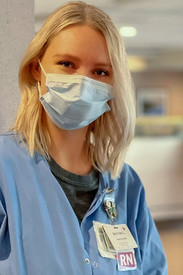 “A strong healthcare system is the foundation of our communities’ well-being and it’s also the foundation of a healthy economy,” said DWD Secretary-designee Amy Pechacek. “Through Gov. Tony Evers’ historic investment in the Workforce Innovation Grant program, this project will make a real difference in bringing more nurses into teaching and clinical roles.” “A strong healthcare system is the foundation of our communities’ well-being and it’s also the foundation of a healthy economy,” said DWD Secretary-designee Amy Pechacek. “Through Gov. Tony Evers’ historic investment in the Workforce Innovation Grant program, this project will make a real difference in bringing more nurses into teaching and clinical roles.”
Addressing Wisconsin’s nursing shortage requires the state, higher education and health care providers to look for new ways to create training opportunities and space in the state’s nursing degree programs, said Missy Hughes, WEDC secretary and CEO.
“Wisconsin is fortunate that so many young people already know that nursing is an important, demanding but fulfilling and family-supporting career choice,” Hughes said. “Now we must increase our training capacity to give these future nurses the skills they will need. Part of what is so exciting about this project is the potential for it to be replicated across the state and increase the number of nurses trained in Wisconsin each year.”
Aurora BayCare Medical Center President Thomas Miller praised the partnership for addressing an underlying challenge in healthcare.
“We hope our unique collaboration with academic nursing programs will help to provide the additional clinical training needed to expand the supply of nursing educators and ease the bottleneck in the nursing workforce,” Miller said. “We’re honored to be a part of this important partnership and applaud our exceptional nursing staff for making it possible.”
Susan Gallagher-Lepak, Dean of the College of Health, Education and Social Welfare at UW-Green Bay, said the $376,000 project will strengthen the partnerships between academic and healthcare organizations and ensure a pipeline of new nurses. Successful deployment of the model in Green Bay will provide clinical training to 152 nursing students over the 2 ½ year project period and sustain annual capacity of 80 students going forward.
“Although 3,000 Wisconsin nurses enter the field each year, we know the nursing gap is real and without intervention, it’s projected to grow to nearly 20,000 by 2035,” Gallagher-Lepak said. “While there is great interest in nursing programs from students, there is a limit to how many students can be admitted because of a shortage of nursing faculty. The partners in this program are responding to the need with an innovative program that we believe will be scalable for the state as a whole – and a model for the nation.”
In December, Gov. Evers announced the first round of 12 Workforce Innovation grants worth about $59.5 million. Starting in June, Gov. Evers announced a second round of Workforce Innovation Grants worth $68.8 million awarded to 15 collaborations across the state. Throughout the fall, Hughes, Pechacek and other members of Governor Evers’ administration are traveling the state to visit the second-round projects and see how these grants are transforming Wisconsin’s workforce.
Learn more about the $150 million Workforce Solutions Initiative, including the $128 million Workforce Innovation Grants.
|
